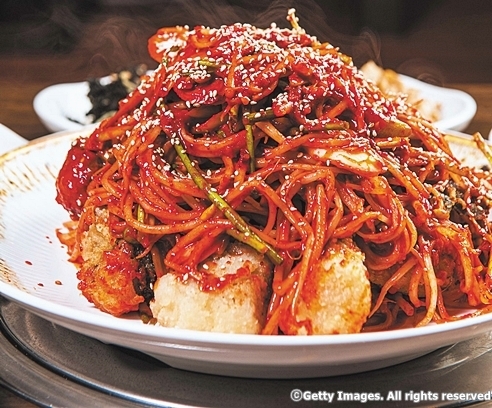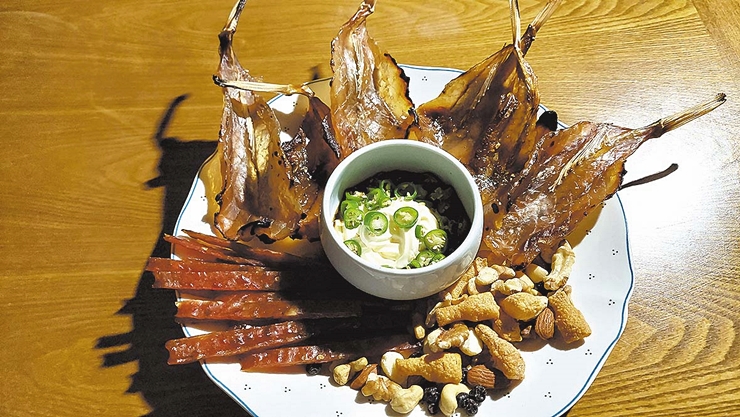Food
Monkfish is the ugly delicious MVP of Korean cuisine

Braised monkfish and soybean sprouts is a warm and comforting dish for many Koreans.
With a large head, bulging eyes and a gaping mouth full of needle-like teeth, the monkfish is undoubtedly in the running for the ugliest sea creature. Often referred to as a "sea devil," it earns this moniker based on appearance alone.
However, in the culinary world, appearances can be deceiving. In kitchens, monkfish have more savory nicknames, such as "tenderloins of the sea" or "poor man's lobsters." The monkfish's mildly flavored flesh, with a toothsome texture and pleasant, sweet aroma, offers cooks a versatile protein that pairs well with various flavors. Culinary doyenne Julia Child once praised it as "a cook's delight." Whether steamed and topped with a squeeze of lemon or braised Korean-style in a red spicy sauce, monkfish is the star of many memorable meals.
Monkfish is a delicious and healthy seafood option, low in calories and sodium but high in protein and rich in nutrients. It boasts high levels of phosphorus to promote bone and teeth health, vitamins B6 and B12 to maintain nervous system and brain function, and selenium to protect cells from damage or infection.
Few foods are as tasty and health-boosting as monkfish, which is why it is one of the most popular foods in Korea. The Korean term for the fish is "agui," although it is commonly called "agu."
Monkfish restaurants are filled with eaters throughout February when the fish is at peak flavor. Among the most common preparations is "aguijjim," a crowd-pleasing dish of monkfish and soybean sprouts braised in a spicy, gochujang-based sauce.
Aguijjim originated in Masan, around 60 kilometers west of Busan. Masan-style aguijjim is made with dried fish. In contrast, Busan-style aguijjim uses fresh fish. Thanks to the plethora of fresh fish markets citywide, like Jagalchi Market and Busan Cooperative Fish Market, freshly caught monkfish can be found in large quantities and at low prices.

"Agui suyuk" offers diners the cleanest taste of springy monkfish flesh.
Another delicacy found in Busan is "agui suyuk," or boiled monkfish. The epitome of ugly delicious, agui suyuk features cut-up pieces of fish, intestines and all. People enjoy the light and chewy meat and the rich flavor of intestines, even more so if the restaurant also happens to serve the prized liver. A piece of fish dipped in wasabi soy sauce or "chogochujang," a tangy condiment of spicy pepper paste and vinegar, pairs perfectly with a glass of beer or a shot of soju.

"Aguipo" dipped in mayo pairs perfectly with an icy glass of beer.
Speaking of alcohol, "anju" is a Korean term for the variety of foods consumed with alcohol. A commonly eaten anju is "aguipo," or dried monkfish jerky. The jerky comes in different flavors, such as sweet, salty or spicy. While aguipo can be purchased at any corner store, the best is found at dried seafood stalls in Busan's traditional markets, like Bujeon Market or the aforementioned Jagalchi.
■ Busan's top monkfish restaurants
◎Daetimulkkong (대티물꽁)
The restaurant has a cozy decor and is filled with artifacts that elicit feelings of nostalgia for a bygone era. The beloved hole-in-the-wall specializes in aguijjim served in generous portions at affordable prices.
•Address: 15 Nakdong-daero 135beonan-gil, Saha-gu
•Hours: Open 11:30 a.m. to 9:30 p.m. Closed on public holidays.
◎Mulkkong Sikdang (물꽁식당)
Run by the same family for three generations, this monkfish institution has been around for 60 years. The restaurant's signature dish is its mild aguijjim, which uses only the highest quality fresh fish caught in the ocean nearby.
•Address: 3 Heukgyo-ro 59beon-gil, Jung-gu
•Hours: Open 10 a.m. to 10 p.m. Closed on public holidays.
<Voca Spotlight>
braise: 졸이다, 익히다
bulging: 불룩 튀어나온
gaping: 벌어진
monkfish: 아귀
moniker: 별명, 이명
culinary: 요리의
savory: 감칠맛나는, 짭짤한
tenderloin: [부위] 안심
toothsome texture: 씩는 질감, 식감
versatile: 다재다능한, 활용도가 높은
sodium: 소듐(나트륨)
phosphorus: 인산
selenium: 셀레늄
soybean sprouts: 콩나물
plethora: 풍부한
boil: 삶다
epitome: 본보기, 전형
intestine: 내장
tangy: 톡 쏘는
condiment: 조미료
vinegar: 식초
aforementioned: 앞서 말한

